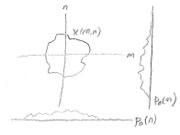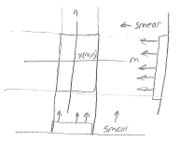| (45 intermediate revisions by the same user not shown) | |||
| Line 1: | Line 1: | ||
<br> | <br> | ||
| + | <center> | ||
| + | <font size="4"> [[ECE_PhD_Qualifying_Exams|ECE Ph.D. Qualifying Exam]] </font> | ||
| − | = | + | <font size="4"> Communication Networks Signal and Image processing (CS) </font> |
| − | + | ||
| − | + | ||
| + | <font size="4"> [[QE637_sol2013|Question 5, August 2013(Published on May 2017)]]</font> | ||
| + | </center> | ||
| + | |||
| + | <font size="4">[[ QE637_sol2013_Q1 | Problem 1]],[[ QE637_sol2013_Q2 |2]]</font> | ||
---- | ---- | ||
| Line 11: | Line 15: | ||
a) | a) | ||
| + | |||
<math> | <math> | ||
| − | + | {{P}_{0}}({{e}^{j\omega }})=\sum\limits_{n=-\infty }^{\infty }{{{p}_{0}}(n){{e}^{-jn\omega }}}=\sum\limits_{n=-\infty }^{\infty }{\left( \sum\limits_{m=-\infty }^{\infty }{x(m,n)} \right){{e}^{-jn\omega }}}=\sum\limits_{m=-\infty }^{\infty }{\sum\limits_{n=-\infty }^{\infty }{x(m,n)}{{e}^{-j(m0+n\omega )}}=X({{e}^{j0}},{{e}^{j\omega }})} | |
| − | </math | + | </math> |
| − | + | b) | |
| − | + | <math> | |
| − | x(m,n)e^{- | + | {{P}_{1}}({{e}^{j\omega }})=\sum\limits_{m=-\infty }^{\infty }{{{p}_{1}}(m){{e}^{-jm\omega }}}=\sum\limits_{m=-\infty }^{\infty }{\left( \sum\limits_{n=-\infty }^{\infty }{x(m,n)} \right){{e}^{-jm\omega }}}=\sum\limits_{m=-\infty }^{\infty }{\sum\limits_{n=-\infty }^{\infty }{x(m,n)}{{e}^{-j(m\omega +n0)}}=X({{e}^{j\omega }},{{e}^{j0}})} |
| + | </math> | ||
| − | + | c) | |
| − | <math> | + | <math> |
| − | + | \sum\limits_{n=-\infty }^{\infty }{{{p}_{0}}(n)}=\sum\limits_{n=-\infty }^{\infty }{\left( \sum\limits_{m=-\infty }^{\infty }{x(m,n)} \right)}=\sum\limits_{m=-\infty }^{\infty }{\sum\limits_{n=-\infty }^{\infty }{x(m,n)}{{e}^{-j(m0+n0)}}=X({{e}^{j0}},{{e}^{j0}})} | |
| − | + | </math> | |
| − | + | d) | |
| − | + | No, they don’t. From part (a) and (b), we know that <math>{{P}_{0}}({{e}^{jw}})</math> and <math>{{P}_{1}}({{e}^{jw}})</math> represent the horizontal and vertical axes of the 2D DSFT <math>X({{e}^{j\mu }},{{e}^{j\upsilon }})</math>, which is not enough for reconstruction of x(m, n). | |
| − | + | ||
| − | which is | + | |
| − | + | For example, <math>{{x}_{1}}(m,n)=\left( \begin{matrix} | |
| − | + | 1 & 3 \\ | |
| − | + | 2 & 4 \\ | |
| − | + | \end{matrix} \right),_{{}}^{{}} and\ {{x}_{2}}(m,n)=\left( \begin{matrix} | |
| − | \left | + | 0 & 4 \\ |
| − | 1 | + | 3 & 3 \\ |
| − | + | \end{matrix} \right)</math> | |
| − | \end{ | + | have the same <math>{{p}_{0}}(n)=\left[ \begin{matrix} |
| − | + | 3 & 7 \\ | |
| − | + | \end{matrix} \right]\ and\ {{p}_{1}}(m)=\left[ \begin{matrix} | |
| − | + | 4 \\ | |
| − | \left[ | + | 6 \\ |
| − | + | \end{matrix} \right]</math>. So, x(m,n) can’t be reconstructed from <math>{{p}_{0}}(n)\ and\ {{p}_{1}}(m)</math>. | |
| − | + | ||
| − | \end{ | + | |
== Solution 2: == | == Solution 2: == | ||
| − | a) | + | a) |
| − | <math> | + | <math> |
| − | + | {{P}_{0}}({{e}^{j\omega }})=\sum\limits_{n=-\infty }^{\infty }{\sum\limits_{m=-\infty }^{\infty }{x(m,n)} {{e}^{-jn\omega }}}=X({{e}^{j0}},{{e}^{j\omega }}) | |
| + | </math> | ||
| − | + | <span style="color:green"> The answer is correct, but multiple steps are skipped in this solution, which are necessary for clarity. (See Solution 1) </span> | |
| − | + | b) | |
| − | + | <math> | |
| + | {{P}_{1}}({{e}^{j\omega }})=\sum\limits_{m=-\infty }^{\infty }{\sum\limits_{n=-\infty }^{\infty }{x(m,n)}{{e}^{-jm\omega }}}=X({{e}^{j\omega }},{{e}^{j0}}) | ||
| + | </math> | ||
| − | < | + | <span style="color:green"> The answer is correct, but multiple steps are skipped in this solution, which are necessary for clarity. (See Solution 1) </span> |
| − | + | ||
| − | + | c) | |
| − | <math> | + | <math> |
| + | \sum\limits_{n=-\infty }^{\infty }{{{p}_{0}}(n)}=\sum\limits_{n=-\infty }^{\infty }{\sum\limits_{m=-\infty }^{\infty }{x(m,n)}=X({{e}^{j0}},{{e}^{j0}})} | ||
| + | </math> | ||
| − | <span style="color:green"> | + | <span style="color:green"> The answer is correct, but multiple steps are skipped in this solution, which are necessary for clarity. (See Solution 1) </span> |
| + | d) | ||
| − | + | They do not; <math>{{p}_{0}}(n)\ and\ {{p}_{1}}(m)</math> are projections at two angles, and do not contain enough information to reconstruct x(m,n). | |
| + | [[File:sol2_2013_1d_1.jpg|thumbnail|center]] | ||
| + | <math> | ||
| + | \begin{align} | ||
| + | & X({{e}^{j\mu }},{{e}^{j\upsilon }})=\sum\limits_{m=-\infty }^{\infty }{\left[ \sum\limits_{n=-\infty }^{\infty }{x(m,n)} \right]}{{e}^{-jm\mu }}{{e}^{-jn\upsilon }} \\ | ||
| + | & X({{e}^{j\mu }},{{e}^{j\upsilon }})\ne \sum\limits_{m=-\infty }^{\infty }{{{p}_{1}}(m)}{{e}^{-jm\mu }}{{e}^{-jn\upsilon }}\ne {{P}_{1}}({{e}^{j\mu }}){{e}^{-jn\upsilon }} \\ | ||
| + | & \Rightarrow Can't\ do\ it! | ||
| + | \end{align}</math> | ||
| − | |||
| − | |||
| − | + | - To form reconstruction, need projections along many angles. | |
| − | + | - Could reconstruct a very simple object, like triangle. | |
| + | [[File:sol2_2013_1d_2.jpg|thumbnail|center]] | ||
| − | + | <span style="color:green"> In the first figure, the projection of x(m,n) along the vertical axis is <math>{{p}_{1}}(m)\</math>, not <math>\ {{p}_{0}}(m)</math>.</span> | |
| − | <math> | + | <span style="color:green"> In the second line of equations, <math>=</math> must be used instead of <math>\ne</math>. </span> |
| − | + | ||
| − | + | ||
| − | + | ||
| − | + | ||
| − | + | ||
| − | + | ||
| − | + | ||
| − | + | ||
| − | + | ||
| − | + | ||
| − | <span | + | <span style="color:green"> Also, the question asks for a counter example if the answer is no! </span> |
| − | + | ||
| − | + | ||
| − | + | ||
| − | + | ||
---- | ---- | ||
| Line 104: | Line 103: | ||
=== Related Problem === | === Related Problem === | ||
| − | + | Consider the 2D discrete space signal <span class="texhtml">''x''(''m'',''n'') with the DSFT of <span class="texhtml">''X''(''e''<sup>''j''μ</sup>,''e''<sup>''j''ν</sup>) given by </span></span> | |
| + | |||
| + | <center> | ||
| + | <math>X(e^{j\mu},e^{j\nu}) = \sum_{m=-\infty}^{\infty} \sum_{n=-\infty}^{\infty} | ||
| + | x(m,n)e^{-j(m\mu+n\nu)}</math> | ||
| + | </center> | ||
| + | |||
| + | Then define | ||
| + | <center> | ||
| + | <math>p_{0}(n) = \sum_{m=-\infty}^{\infty}x(m,n)</math><br> | ||
| + | |||
| + | <math>p_{1}(m) = \sum_{n=-\infty}^{\infty}x(m,n)</math> | ||
| + | </center> | ||
| + | |||
| + | with corresponding DTFT given by | ||
| + | <center> | ||
| + | <math>P_{0}(e^{j\omega}) = \sum_{n=-\infty}^{\infty} p_{0}(n)e^{-jn\omega}</math><br> | ||
| + | |||
| + | <math>P_{1}(e^{j\omega}) = \sum_{m=-\infty}^{\infty} p_{0}(m)e^{-jm\omega}</math><br> | ||
| + | </center> | ||
| − | a) | + | a) Derive an expression for <span class="texhtml">''P''<sub>0</sub>(''e''<sup>''j''ω</sup>)</span> in terms of <span class="texhtml">''X''(''e''<sup>''j''μ</sup>,''w''<sup>''j''ν</sup>)</span>. |
| − | + | b) Derive an expression <span class="texhtml">''P''<sub>0</sub>(''e''<sup>''j''ω</sup>)</span> in terms of <span class="texhtml">''X''(''e''<sup>''j''μ</sup>,''e''<sup>''j''ν</sup>)</span>. | |
| − | <math>p( | + | c) Find a function x(m,n) that is not zero everywhere such that <math>{{p}_{0}}(n)={{p}_{1}}(m)=0</math> for all m and n. |
| − | + | d) Do the function <span class="texhtml">''p''<sub>0</sub>(''n'')</span> and <span class="texhtml">''p''<sub>1</sub>(''m'')</span> together contain sufficient information to uniquely reconstruct the function <span class="texhtml">''x''(''m'',''n'')</span>? Justify your answer. | |
| − | (Refer to | + | (Refer to <u>[https://engineering.purdue.edu/~bouman/ece637/previous/ece637S2015/exams/exam1/exam.pdf ECE 637 Spring 2015 Exam 1 Problem 2].</u>) |
---- | ---- | ||
Latest revision as of 20:03, 2 May 2017
Communication Networks Signal and Image processing (CS)
Problem 1,2
Solution 1:
a)
$ {{P}_{0}}({{e}^{j\omega }})=\sum\limits_{n=-\infty }^{\infty }{{{p}_{0}}(n){{e}^{-jn\omega }}}=\sum\limits_{n=-\infty }^{\infty }{\left( \sum\limits_{m=-\infty }^{\infty }{x(m,n)} \right){{e}^{-jn\omega }}}=\sum\limits_{m=-\infty }^{\infty }{\sum\limits_{n=-\infty }^{\infty }{x(m,n)}{{e}^{-j(m0+n\omega )}}=X({{e}^{j0}},{{e}^{j\omega }})} $
b)
$ {{P}_{1}}({{e}^{j\omega }})=\sum\limits_{m=-\infty }^{\infty }{{{p}_{1}}(m){{e}^{-jm\omega }}}=\sum\limits_{m=-\infty }^{\infty }{\left( \sum\limits_{n=-\infty }^{\infty }{x(m,n)} \right){{e}^{-jm\omega }}}=\sum\limits_{m=-\infty }^{\infty }{\sum\limits_{n=-\infty }^{\infty }{x(m,n)}{{e}^{-j(m\omega +n0)}}=X({{e}^{j\omega }},{{e}^{j0}})} $
c)
$ \sum\limits_{n=-\infty }^{\infty }{{{p}_{0}}(n)}=\sum\limits_{n=-\infty }^{\infty }{\left( \sum\limits_{m=-\infty }^{\infty }{x(m,n)} \right)}=\sum\limits_{m=-\infty }^{\infty }{\sum\limits_{n=-\infty }^{\infty }{x(m,n)}{{e}^{-j(m0+n0)}}=X({{e}^{j0}},{{e}^{j0}})} $
d)
No, they don’t. From part (a) and (b), we know that $ {{P}_{0}}({{e}^{jw}}) $ and $ {{P}_{1}}({{e}^{jw}}) $ represent the horizontal and vertical axes of the 2D DSFT $ X({{e}^{j\mu }},{{e}^{j\upsilon }}) $, which is not enough for reconstruction of x(m, n).
For example, $ {{x}_{1}}(m,n)=\left( \begin{matrix} 1 & 3 \\ 2 & 4 \\ \end{matrix} \right),_{{}}^{{}} and\ {{x}_{2}}(m,n)=\left( \begin{matrix} 0 & 4 \\ 3 & 3 \\ \end{matrix} \right) $ have the same $ {{p}_{0}}(n)=\left[ \begin{matrix} 3 & 7 \\ \end{matrix} \right]\ and\ {{p}_{1}}(m)=\left[ \begin{matrix} 4 \\ 6 \\ \end{matrix} \right] $. So, x(m,n) can’t be reconstructed from $ {{p}_{0}}(n)\ and\ {{p}_{1}}(m) $.
Solution 2:
a)
$ {{P}_{0}}({{e}^{j\omega }})=\sum\limits_{n=-\infty }^{\infty }{\sum\limits_{m=-\infty }^{\infty }{x(m,n)} {{e}^{-jn\omega }}}=X({{e}^{j0}},{{e}^{j\omega }}) $
The answer is correct, but multiple steps are skipped in this solution, which are necessary for clarity. (See Solution 1)
b)
$ {{P}_{1}}({{e}^{j\omega }})=\sum\limits_{m=-\infty }^{\infty }{\sum\limits_{n=-\infty }^{\infty }{x(m,n)}{{e}^{-jm\omega }}}=X({{e}^{j\omega }},{{e}^{j0}}) $
The answer is correct, but multiple steps are skipped in this solution, which are necessary for clarity. (See Solution 1)
c)
$ \sum\limits_{n=-\infty }^{\infty }{{{p}_{0}}(n)}=\sum\limits_{n=-\infty }^{\infty }{\sum\limits_{m=-\infty }^{\infty }{x(m,n)}=X({{e}^{j0}},{{e}^{j0}})} $
The answer is correct, but multiple steps are skipped in this solution, which are necessary for clarity. (See Solution 1)
d)
They do not; $ {{p}_{0}}(n)\ and\ {{p}_{1}}(m) $ are projections at two angles, and do not contain enough information to reconstruct x(m,n).
$ \begin{align} & X({{e}^{j\mu }},{{e}^{j\upsilon }})=\sum\limits_{m=-\infty }^{\infty }{\left[ \sum\limits_{n=-\infty }^{\infty }{x(m,n)} \right]}{{e}^{-jm\mu }}{{e}^{-jn\upsilon }} \\ & X({{e}^{j\mu }},{{e}^{j\upsilon }})\ne \sum\limits_{m=-\infty }^{\infty }{{{p}_{1}}(m)}{{e}^{-jm\mu }}{{e}^{-jn\upsilon }}\ne {{P}_{1}}({{e}^{j\mu }}){{e}^{-jn\upsilon }} \\ & \Rightarrow Can't\ do\ it! \end{align} $
- To form reconstruction, need projections along many angles.
- Could reconstruct a very simple object, like triangle.
In the first figure, the projection of x(m,n) along the vertical axis is $ {{p}_{1}}(m)\ $, not $ \ {{p}_{0}}(m) $.
In the second line of equations, $ = $ must be used instead of $ \ne $.
Also, the question asks for a counter example if the answer is no!
Related Problem
Consider the 2D discrete space signal x(m,n) with the DSFT of X(ejμ,ejν) given by
$ X(e^{j\mu},e^{j\nu}) = \sum_{m=-\infty}^{\infty} \sum_{n=-\infty}^{\infty} x(m,n)e^{-j(m\mu+n\nu)} $
Then define
$ p_{0}(n) = \sum_{m=-\infty}^{\infty}x(m,n) $
$ p_{1}(m) = \sum_{n=-\infty}^{\infty}x(m,n) $
with corresponding DTFT given by
$ P_{0}(e^{j\omega}) = \sum_{n=-\infty}^{\infty} p_{0}(n)e^{-jn\omega} $
$ P_{1}(e^{j\omega}) = \sum_{m=-\infty}^{\infty} p_{0}(m)e^{-jm\omega} $
a) Derive an expression for P0(ejω) in terms of X(ejμ,wjν).
b) Derive an expression P0(ejω) in terms of X(ejμ,ejν).
c) Find a function x(m,n) that is not zero everywhere such that $ {{p}_{0}}(n)={{p}_{1}}(m)=0 $ for all m and n.
d) Do the function p0(n) and p1(m) together contain sufficient information to uniquely reconstruct the function x(m,n)? Justify your answer.
(Refer to ECE 637 Spring 2015 Exam 1 Problem 2.)



